The compact SUV segment has seen remarkable growth, with Ford's Puma and Nissan's Juke standing out as notable contenders. Both vehicles blend style, modern technology, and practicality, but how do they stack up against each other? This comparison dives into the technical aspects and innovations of the Ford Puma and Nissan Juke, helping you decide which model suits your lifestyle better.
Ford Puma vs Nissan Juke – Which car suits you better?
Two cars, one duel: Ford Puma meets Nissan Juke.
Which one wins in performance, efficiency and value for money? Find out now!
Design and Dimensions
When it comes to looks, both vehicles offer a sporty profile that appeals to urban drivers. The Ford Puma measures 4186 mm in length, 1805 mm in width, and has a height of 1550 mm. The Nissan Juke, while slightly longer at 4210 mm, matches Ford's width but is taller at 1593 mm. This extra height in the Juke may provide a more commanding view of the road, but the Puma presents a sleeker silhouette overall.
Powertrain and Performance
The Ford Puma is available with a choice of petrol mild-hybrid and electric engines, with power output ranging from 125 to 168 HP. Notably, the electric variant boasts an impressive range of up to 376 km on a single charge, and the acceleration can achieve 0-100 km/h in as little as 7.4 seconds. In contrast, the Nissan Juke features petrol and full hybrid options, offering power levels from 114 to 143 HP. With a slightly slower 0-100 km/h time of 10.1 seconds, it sacrifices some acceleration for efficiency, especially considering its lower fuel consumption rate of 4.7 L/100 km in the hybrid variant.
Fuel Efficiency and Emissions
Speaking of efficiency, the Puma showcases a fuel consumption range of 5.4 to 6 L/100 km for its petrol engines, while its electric model's consumption stands at 13.1 kWh/100 km. The Nissan Juke, on the other hand, offers slightly higher consumption figures—5.8 to 6 L/100 km—with its traditional petrol engines. The Juke’s hybrid model proves more environmentally friendly with a CO2 emission level of 107 g/km, while the Puma varies from 121 to 136 g/km depending on the engine.
Interior and Practicality
In terms of interior space, both models cater to five occupants comfortably. The Ford Puma provides impressive trunk capacity of 456 to 523 liters, making it a better choice for families or those who require extra storage. The Nissan Juke’s trunk space is notably smaller, offering up to 422 liters. Both vehicles boast user-friendly infotainment systems, with Ford incorporating the latest technology to enhance the driving experience, including a FordPass app for remote features.
Innovative Features
One of the star innovations in the Ford Puma is its advanced hybrid technology paired with the option of a hybrid-like electric range. Ford has also integrated a host of driver-assist technologies to ensure safety and comfort on the road. Meanwhile, the Nissan Juke proudly offers the Nissan Intelligent Mobility suite, providing features such as ProPILOT Assist, which makes highway driving easier and safer.
Conclusion
Choosing between the Ford Puma and Nissan Juke ultimately comes down to personal preference and specific needs. If practicality and advanced hybrid technology are at the top of your list, the Ford Puma has the edge. Alternatively, if you're looking for a stylish, compact SUV with strong hybrid efficiency, the Nissan Juke could be your perfect match. Both vehicles offer a blend of technology, comfort, and performance, ensuring that either choice will make for an exciting driving experience.
Here’s where it gets real: The technical differences in detail
Costs and Efficiency:
Price and efficiency are often the first things buyers look at. Here it becomes clear which model has the long-term edge – whether at the pump, the plug, or in purchase price.
Nissan Juke has a slightly advantage in terms of price – it starts at 21400 £, while the Ford Puma costs 24800 £. That’s a price difference of around 3386 £.
Fuel consumption also shows a difference: Nissan Juke manages with 4.70 L and is therefore somewhat more efficient than the Ford Puma with 5.40 L. The difference is about 0.70 L per 100 km.
Engine and Performance:
Power, torque and acceleration are the classic benchmarks for car enthusiasts – and here, some clear differences start to show.
When it comes to engine power, the Ford Puma has a a bit edge – offering 168 HP compared to 143 HP. That’s roughly 25 HP more horsepower.
In acceleration from 0 to 100 km/h, the Ford Puma is clearly perceptible quicker – completing the sprint in 7.40 s, while the Nissan Juke takes 10.10 s. That’s about 2.70 s faster.
In terms of top speed, the Ford Puma performs a bit better – reaching 210 km/h, while the Nissan Juke tops out at 180 km/h. The difference is around 30 km/h.
There’s also a difference in torque: Ford Puma pulls noticeable stronger with 290 Nm compared to 200 Nm. That’s about 90 Nm difference.
Space and Everyday Use:
Beyond pure performance, interior space and usability matter most in daily life. This is where you see which car is more practical and versatile.
Both vehicles offer seating for 5 people.
In curb weight, Nissan Juke is hardly perceptible lighter – 1274 kg compared to 1316 kg. The difference is around 42 kg.
In terms of boot space, the Ford Puma offers somewhat more room – 523 L compared to 422 L. That’s a difference of about 101 L.
In maximum load capacity, the Nissan Juke performs hardly perceptible better – up to 1305 L, which is about 22 L more than the Ford Puma.
When it comes to payload, Ford Puma hardly perceptible takes the win – 469 kg compared to 427 kg. That’s a difference of about 42 kg.
Who comes out on top?
Overall, the Ford Puma shows itself to be is largely superior and secures the title of DriveDuel Champion.
It convinces with the more balanced overall package and proves to be the more versatile choice for everyday use.
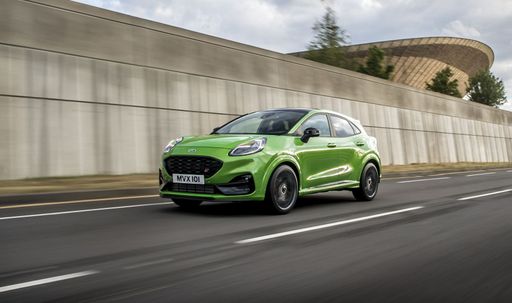 @ Ford Motor Company / Ford Media Center
@ Ford Motor Company / Ford Media Center
Ford Puma
Ford Puma
The Ford Puma is a cheeky compact crossover that blends sporty styling with city-friendly practicality, giving drivers a surprisingly fun and composed ride. With clever storage tricks and a lively personality, it’s a smart pick for buyers who want enjoyment without fuss.
details @ Ford Motor Company / Ford Media Center
@ Ford Motor Company / Ford Media Center
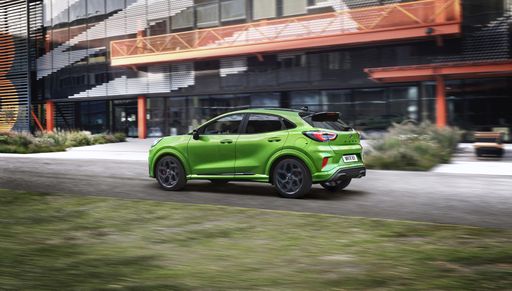 @ Ford Motor Company / Ford Media Center
@ Ford Motor Company / Ford Media Center
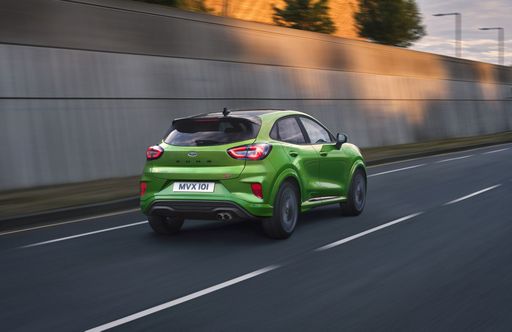 @ Ford Motor Company / Ford Media Center
@ Ford Motor Company / Ford Media Center
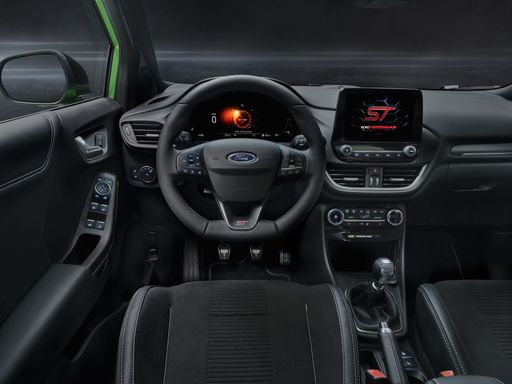 @ Ford Motor Company / Ford Media Center
@ Ford Motor Company / Ford Media Center
Nissan Juke
The Nissan Juke is a pocket-sized crossover that refuses to blend in, with quirky styling and a cheeky stance that turns heads at every traffic light. It’s ideal for shoppers who value personality and nimble urban driving over maximum practicality, delivering surprising pep and a well-equipped feel for everyday fun.
details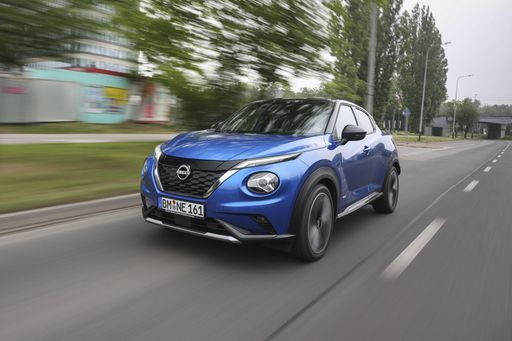 @ Nissan Motor Corporation
@ Nissan Motor Corporation
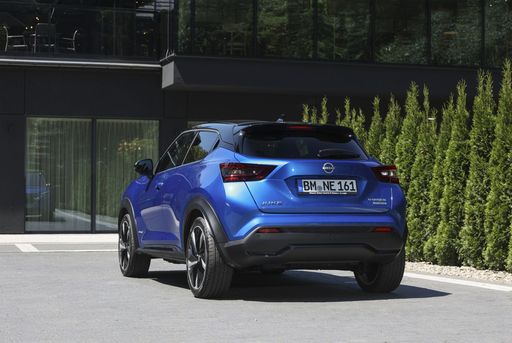 @ Nissan Motor Corporation
@ Nissan Motor Corporation
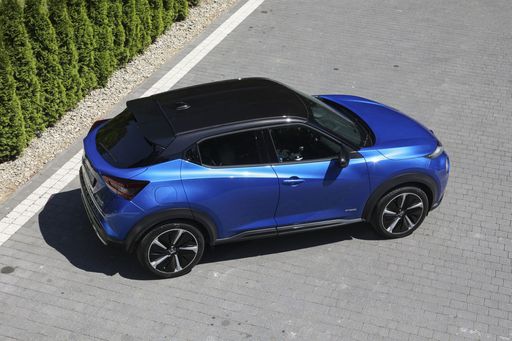 @ Nissan Motor Corporation
@ Nissan Motor Corporation
 @ Nissan Motor Corporation
@ Nissan Motor Corporation
 @ Ford Motor Company / Ford Media Center
@ Ford Motor Company / Ford Media Center
|
 @ Nissan Motor Corporation
@ Nissan Motor Corporation
|
|
|
|
Costs and Consumption |
|
|---|---|
|
Price
24800 - 36300 £
|
Price
21400 - 30100 £
|
|
Consumption L/100km
5.4 - 5.9 L
|
Consumption L/100km
4.7 - 6 L
|
|
Consumption kWh/100km
13.1 - 13.9 kWh
|
Consumption kWh/100km
-
|
|
Electric Range
361 - 376 km
|
Electric Range
-
|
|
Battery Capacity
43 kWh
|
Battery Capacity
0.60 kWh
|
|
co2
0 - 135 g/km
|
co2
107 - 136 g/km
|
|
Fuel tank capacity
42 L
|
Fuel tank capacity
46 L
|
Dimensions and Body |
|
|---|---|
|
Body Type
SUV
|
Body Type
SUV
|
|
Seats
5
|
Seats
5
|
|
Doors
5
|
Doors
5
|
|
Curb weight
1316 - 1563 kg
|
Curb weight
1274 - 1405 kg
|
|
Trunk capacity
456 - 523 L
|
Trunk capacity
354 - 422 L
|
|
Length
4186 - 4226 mm
|
Length
4210 mm
|
|
Width
1805 mm
|
Width
1800 mm
|
|
Height
1550 - 1555 mm
|
Height
1593 mm
|
|
Max trunk capacity
1216 - 1283 L
|
Max trunk capacity
1237 - 1305 L
|
|
Payload
367 - 469 kg
|
Payload
405 - 427 kg
|
Engine and Performance |
|
|---|---|
|
Engine Type
Electric, Petrol MHEV
|
Engine Type
Petrol, Full Hybrid
|
|
Transmission
Automatic, Manuel
|
Transmission
Manuel, Automatic
|
|
Transmission Detail
Reduction Gearbox, Manual Gearbox, Dual-Clutch Automatic
|
Transmission Detail
Manual Gearbox, Dual-Clutch Automatic, Automatic Gearbox
|
|
Drive Type
Front-Wheel Drive
|
Drive Type
Front-Wheel Drive
|
|
Power HP
125 - 168 HP
|
Power HP
114 - 143 HP
|
|
Acceleration 0-100km/h
7.4 - 9.8 s
|
Acceleration 0-100km/h
10.1 - 11.8 s
|
|
Max Speed
160 - 210 km/h
|
Max Speed
166 - 180 km/h
|
|
Torque
170 - 290 Nm
|
Torque
200 Nm
|
|
Number of Cylinders
3
|
Number of Cylinders
3 - 4
|
|
Power kW
92 - 124 kW
|
Power kW
84 - 105 kW
|
|
Engine capacity
999 cm3
|
Engine capacity
999 - 1598 cm3
|
General |
|
|---|---|
|
Model Year
2025
|
Model Year
2024
|
|
CO2 Efficiency Class
A, D
|
CO2 Efficiency Class
D, E, C
|
|
Brand
Ford
|
Brand
Nissan
|
Is the Ford Puma offered with different drivetrains?
The Ford Puma is offered with Front-Wheel Drive.
The prices and data displayed are estimates based on German list prices and may vary by country. This information is not legally binding.
